|
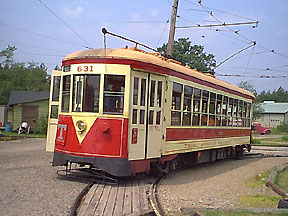 "Don’t
Talk to the Motorman," said the sign at the front of every trolley.
This plus the clang of the bell, the grind of traction motors and the
clatter of wheels as they rolled over staggered rail joints and through the
complicated switch and crossing work prevailing at many intersections
endeared the trolley to several generations of riders. "Don’t
Talk to the Motorman," said the sign at the front of every trolley.
This plus the clang of the bell, the grind of traction motors and the
clatter of wheels as they rolled over staggered rail joints and through the
complicated switch and crossing work prevailing at many intersections
endeared the trolley to several generations of riders.
The Early Years
Despite tremendous difficulties, a young Annapolis graduate named Frank
Sprague built a 12-mile, 40-car line in Richmond, Virginia, which began
service on February 2nd, 1888. Since both its size and survival were
unprecedented, it quickly attracted the attention of horsecar officials all
over the country. Soon, scores of similar lines appeared signaling the birth
of the era of electric traction.
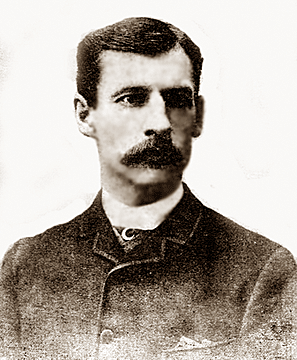 Sprague used and improved the now familiar trolley pole instead of the troller
for power collection and designed a mounting for the motors that kept
the gearing between them and the road wheels in constant mesh. He also
showed that reversing the motors would slow the cars and bring them to a
halt safely. Sprague used and improved the now familiar trolley pole instead of the troller
for power collection and designed a mounting for the motors that kept
the gearing between them and the road wheels in constant mesh. He also
showed that reversing the motors would slow the cars and bring them to a
halt safely.
As the industry rapidly grew and matured, the trolley became part of the
fabric of everyday life. On most lines, even in the smaller cities, there
was a car along every few minutes. On busier routes and in the larger cities
one always seemed to be in sight. During the morning and evening rush hours,
headways (the interval of time between cars) were more likely to be measured
in inches than in minutes, for every car capable of turning a wheel was
pressed into service to cope with the peak loads.
Small towns built systems as short as a mile in length. And big cities
like Boston built systems with hundreds of miles of track. Suburbs grew up
all around larger cities because of reliable, all-weather trolley
transportation. Trolleys were everywhere and took people everywhere they
wanted to go.
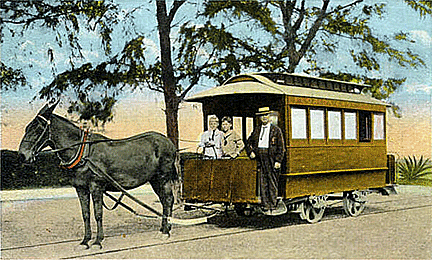 At first, almost every electric line was owned by a different company. So
passengers paid an additional fare each time they changed cars. Around the
turn of the century, a wave of consolidation swept most cities with just one
or two big streetcar companies owning all the routes. These companies soon
discovered that by issuing free transfers between lines, more than enough
additional riders would take the cars to make up for the fares lost.
Ridership soared. At first, almost every electric line was owned by a different company. So
passengers paid an additional fare each time they changed cars. Around the
turn of the century, a wave of consolidation swept most cities with just one
or two big streetcar companies owning all the routes. These companies soon
discovered that by issuing free transfers between lines, more than enough
additional riders would take the cars to make up for the fares lost.
Ridership soared.
Trolley Riders
There was a noticeable air of bravado among the first trolley riders. Men
would hand their pocket watches to their stay-behind womenfolk be cause the
powerful electric currents flowing invisibly about a car might magnetize
them. Some riders joked about how in 1888 New York State had decided to
electrocute murderers. Riders believed it prudent to debark hastily if a
thunderstorm sprang up. On some lines it was a regular practice to stop and
pull-down trolley poles whenever thunder rumbled nearby.
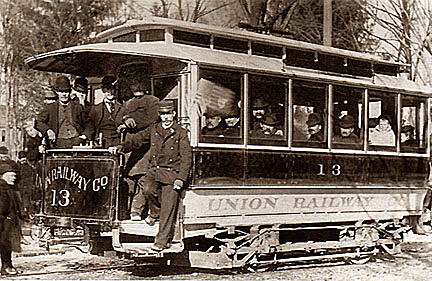 On most small trolley
lines, moreover, there was an endearing tradition of informality, very different from the bleak impersonality of big railroads. When
a regular rider didn't make it to the stop on time in the morning, the
motorman would dally while he or she came puffing up. The daytime conductor
could be bribed into delivering a parcel to a house several blocks away by a
gift of some oven-fresh popovers, or into dropping a letter in the slot at
the depot. Most of the time the trolley's regularity was exact enough to
time the events of domestic life. A wife knew by the screech of the wheels
on the curve down the street at 5:45 PM that their husband was on his way
home from work. On most small trolley
lines, moreover, there was an endearing tradition of informality, very different from the bleak impersonality of big railroads. When
a regular rider didn't make it to the stop on time in the morning, the
motorman would dally while he or she came puffing up. The daytime conductor
could be bribed into delivering a parcel to a house several blocks away by a
gift of some oven-fresh popovers, or into dropping a letter in the slot at
the depot. Most of the time the trolley's regularity was exact enough to
time the events of domestic life. A wife knew by the screech of the wheels
on the curve down the street at 5:45 PM that their husband was on his way
home from work.
Trolleys and Recreation
Electric traction companies built their lines to handle the crowds of
workers going to and from their jobs. But for most of the rest of the time,
the cars ran almost empty. Streetcar companies began to dream up ways to get
people to ride their cars on weekends and holidays. If a car line could
easily be extended to a beach or a natural scenic attraction, a line would
be laid out to the countryside and a picnic grove or amusement park built
there, specifically to generate off-hours traffic.

So the companies actively advertised the pleasures of joy riding. And
people took trolley rides just for fun.
Trolleys were a pleasant way by which to explore unknown parts of a
city-they were leisurely and cheap and afforded a fine car-window view of
the neighborhoods through which they passed. And when there was a specific
destination-the circus, zoo, fair grounds, or lake-just the going there by
trolley was part of the fun, a time of heightened anticipation and
excitement.
At many parks the company saw to it that there was no other way to get in
except by trolley.
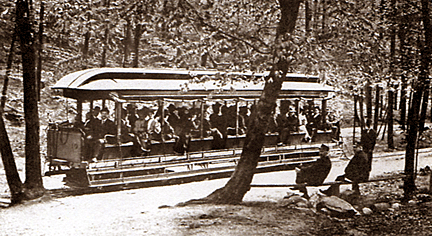 On a typical Saturday, trolleys would glide along past the outskirts of
town, finally swinging in under the arched entrance to Electric Park, as
many of the first amusement parks were called. There the riders debarked to
saunter along the flower-lined walks where tame peacocks strutted on the
grass and the exciting Ferris wheel or giant aerial swings could be glimpsed
beyond the trees. From the moment a person stepped off the trolley he'd hear
the merry-go-round calliope, or the Sousaphone and drums from the bandstand,
or the click and roar of the roller coaster and the screams from its
ecstatically terrified riders. On a typical Saturday, trolleys would glide along past the outskirts of
town, finally swinging in under the arched entrance to Electric Park, as
many of the first amusement parks were called. There the riders debarked to
saunter along the flower-lined walks where tame peacocks strutted on the
grass and the exciting Ferris wheel or giant aerial swings could be glimpsed
beyond the trees. From the moment a person stepped off the trolley he'd hear
the merry-go-round calliope, or the Sousaphone and drums from the bandstand,
or the click and roar of the roller coaster and the screams from its
ecstatically terrified riders.
Hours later, when day was done and the trolley carried its load back to
the city, there was still a feeling of pleasantly fatigued gaiety within the
car. Despite the sunburn and blisters, the frankfurters and taffy lying
leaden in the belly, the querulous baby with sand in its creases, the
collective mood would be voiced by the group in the back of the car that
experimented in harmonies for "By the Light of the Silvery Moon."
This was a Saturday way of life that passed on with the trolley.
Open-Car Trolleys
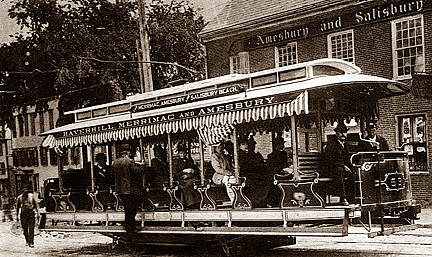 From the earliest days on, open cars were the summertime favorites of the
trolley-riding public. In many communities the open-car trolley party--a car
chartered for an afternoon or evening jaunt, with group singing on the way
home–became popular. Sometimes two or three cars, festooned with garlands
of light bulbs and perhaps a hired band tootling away in the head car, would
be hired for big trolley parties. From the earliest days on, open cars were the summertime favorites of the
trolley-riding public. In many communities the open-car trolley party--a car
chartered for an afternoon or evening jaunt, with group singing on the way
home–became popular. Sometimes two or three cars, festooned with garlands
of light bulbs and perhaps a hired band tootling away in the head car, would
be hired for big trolley parties.
In sweltering weather traction companies would notice evening traffic
increases on open-car routes, reflecting the numbers of people who rode the
cars at random in the evening, just to cool off. In a day without movies,
air conditioning, or electronic amusements, riding nowhere in particular on
a hot evening was a happy custom. Up front the motorman pulled down the
green curtain that shielded his window from reflections. If a thunderstorm blew
up, the conductor unfurled the flapping canvas side curtains and, when a
passenger reached his stop, he briefly raised the section near his bench
while those within crowded together to avoid a splashing.
But though the riding public loved open cars, the companies didn't. It
was a considerable expense, for one thing, to buy and maintain extra rolling
stock that could be used only a few months of the year. From the company
standpoint, open cars had the additional drawback of a slightly higher
accident rate, with accompanying damage suits. People tended to board or
leave open cars in motion; and while it was no trick to swing onto or down
from a car that had slowed to 7 or 8 miles an hour, a missed handhold or
slippery footing could land a person flat on his or her back.
Unfortunately for management, the public liked the open car; and the
little guy who paid the fare that built and maintained many a traction
president's ornate mansion could not be completely ignored. Consequently,
the open trolley car was around for a long time.
Parlor-car Trolleys
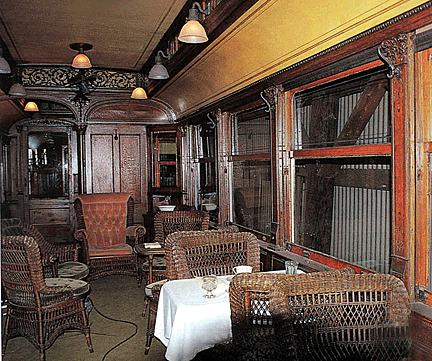 n addition to the usual roster of open and closed passenger cars, the
typical street railway owned a variety of specialized cars. Originally
intended for use by company officials on inspection trips, parlor trolleys
appeared quite widely in the 1890s. n addition to the usual roster of open and closed passenger cars, the
typical street railway owned a variety of specialized cars. Originally
intended for use by company officials on inspection trips, parlor trolleys
appeared quite widely in the 1890s.
Parlor-car trolleys were generally luxurious, with gleaming brass
fittings, richly curtained windows, wall-to-wall
carpeting, decorated ceilings, polished mahogany paneling, and colored glass
in the clerestory. The directors of the Connecticut Traction Company could
avail themselves in their car of a lavatory that was shielded from common
gaze by stained glass windows of almost paralyzing elegance.
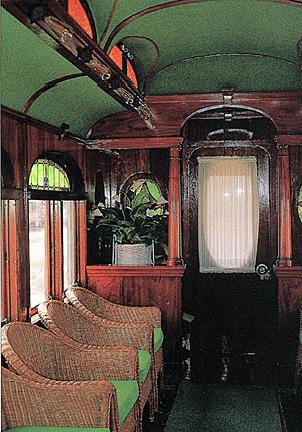 Even though originally built to enhance self esteem of officials, these
deluxe trolleys soon found additional service on charter trips. Many a
citizen would willingly plunk down $20 or $30 on spare-no-expense occasions
such as weddings or anniversaries so that he or she could glide elegantly
through the streets in publicly displayed privacy. Fraternal affairs,
bachelor dinners, and special sightseeing tours for visiting dignitaries
were other parlor-car occasions. Even though originally built to enhance self esteem of officials, these
deluxe trolleys soon found additional service on charter trips. Many a
citizen would willingly plunk down $20 or $30 on spare-no-expense occasions
such as weddings or anniversaries so that he or she could glide elegantly
through the streets in publicly displayed privacy. Fraternal affairs,
bachelor dinners, and special sightseeing tours for visiting dignitaries
were other parlor-car occasions.
Often, too, they were chartered for funerals. Trolley car funerals were
common. Many companies in the larger cities had cars especially built for
the purpose. Frequently named instead of numbered, these cars provided a
special casket compartment up front with plate glass windows and a large
glass door that allowed the coffin to be viewed from the street; a
nickel-plated rail against which flowers could be banked; 8 black leather
seats in the casket compartment for first-degree mourners, and 24 seats in
the rear for lesser grievers. All this for just $20-26.
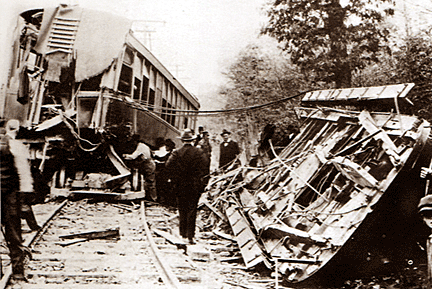 Decline Decline
Electric traction, as the industry was known, reached its physical peak
during World War 1. Following that period there was a gradual decline in the
numbers of route miles of track and cars operated. At first the decline was
barely perceptible-here and there a small company tore up its rails and
pulled down its overhead wires; but mostly these were small, marginal
operations that never should have been built in the first place. Actually,
trolley patronage continued to grow for another six years, until 1923, when
14 billion riders paid to ride the streetcars of the U.S.
This article first appeared in History Magazine.
<
Back to
History Articles
Go to next History article >
|
